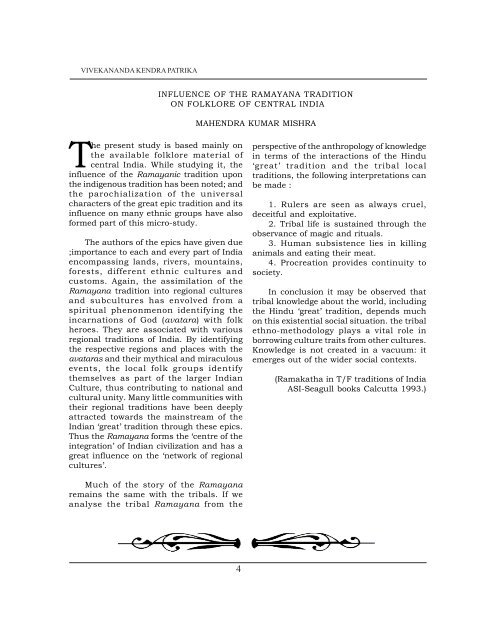Epics in Imprints-1.pdf - Vivekananda Kendra Prakashan
Epics in Imprints-1.pdf - Vivekananda Kendra Prakashan
Epics in Imprints-1.pdf - Vivekananda Kendra Prakashan
You also want an ePaper? Increase the reach of your titles
YUMPU automatically turns print PDFs into web optimized ePapers that Google loves.
VIVEKANANDA KENDRA PATRIKA<br />
The present study is based ma<strong>in</strong>ly on<br />
the available folklore material of<br />
central India. While study<strong>in</strong>g it, the<br />
<strong>in</strong>fluence of the Ramayanic tradition upon<br />
the <strong>in</strong>digenous tradition has been noted; and<br />
the parochialization of the universal<br />
characters of the great epic tradition and its<br />
<strong>in</strong>fluence on many ethnic groups have also<br />
formed part of this micro-study.<br />
The authors of the epics have given due<br />
;importance to each and every part of India<br />
encompass<strong>in</strong>g lands, rivers, mounta<strong>in</strong>s,<br />
forests, different ethnic cultures and<br />
customs. Aga<strong>in</strong>, the assimilation of the<br />
Ramayana tradition <strong>in</strong>to regional cultures<br />
and subcultures has envolved from a<br />
spiritual phenonmenon identify<strong>in</strong>g the<br />
<strong>in</strong>carnations of God (avatara) with folk<br />
heroes. They are associated with various<br />
regional traditions of India. By identify<strong>in</strong>g<br />
the respective regions and places with the<br />
avataras and their mythical and miraculous<br />
events, the local folk groups identify<br />
themselves as part of the larger Indian<br />
Culture, thus contribut<strong>in</strong>g to national and<br />
cultural unity. Many little communities with<br />
their regional traditions have been deeply<br />
attracted towards the ma<strong>in</strong>stream of the<br />
Indian ‘great’ tradition through these epics.<br />
Thus the Ramayana forms the ‘centre of the<br />
<strong>in</strong>tegration’ of Indian civilization and has a<br />
great <strong>in</strong>fluence on the ‘network of regional<br />
cultures’.<br />
Much of the story of the Ramayana<br />
rema<strong>in</strong>s the same with the tribals. If we<br />
analyse the tribal Ramayana from the<br />
INFLUENCE OF THE RAMAYANA TRADITION<br />
ON FOLKLORE OF CENTRAL INDIA<br />
MAHENDRA KUMAR MISHRA<br />
4<br />
perspective of the anthropology of knowledge<br />
<strong>in</strong> terms of the <strong>in</strong>teractions of the H<strong>in</strong>du<br />
‘great’ tradition and the tribal local<br />
traditions, the follow<strong>in</strong>g <strong>in</strong>terpretations can<br />
be made :<br />
1. Rulers are seen as always cruel,<br />
deceitful and exploitative.<br />
2. Tribal life is susta<strong>in</strong>ed through the<br />
observance of magic and rituals.<br />
3. Human subsistence lies <strong>in</strong> kill<strong>in</strong>g<br />
animals and eat<strong>in</strong>g their meat.<br />
4. Procreation provides cont<strong>in</strong>uity to<br />
society.<br />
In conclusion it may be observed that<br />
tribal knowledge about the world, <strong>in</strong>clud<strong>in</strong>g<br />
the H<strong>in</strong>du ‘great’ tradition, depends much<br />
on this existential social situation. the tribal<br />
ethno-methodology plays a vital role <strong>in</strong><br />
borrow<strong>in</strong>g culture traits from other cultures.<br />
Knowledge is not created <strong>in</strong> a vacuum: it<br />
emerges out of the wider social contexts.<br />
(Ramakatha <strong>in</strong> T/F traditions of India<br />
ASI-Seagull books Calcutta 1993.)

















